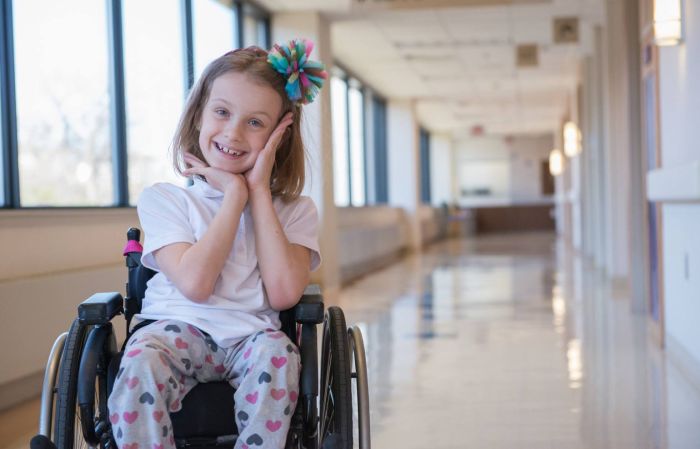What is a tethered spinal cord?
A tethered spinal cord occurs when the spinal cord is pulled down and is stuck or attached to the base of the spine’s surrounding tissue. This prevents the spinal cord from moving freely in the spinal canal as it normally would. If the spinal cord is tethered, it will stretch like a rubber band in response to the restriction. This pressure may cause pain and permanent damage to the spinal tissue and nerves if left untreated.
What are the symptoms of a tethered spinal cord in children?
Initial tethered spinal cord symptoms in children may be visible on the lower back. The symptoms may include:
- A patch of discolored skin
- A wound or lesion
- A patch of hair
- A deep dimple (usually seen with other signs and symptoms)
- A fatty mass
Other common tethered spinal cord symptoms in children vary, and may include:
- Leg and back pain
- Increased muscle spasms
- Numbness or weakness in the feet or legs
- Deformities in feet (like high arches or curled toes)
- Changes in, or trouble with, bladder and bowel function
- Abnormal spine curvature (scoliosis)
If your child has tethered spinal cord symptoms, seeking a diagnosis and treatment can help to avoid the possibility of lasting nerve damage. In some cases, children may not show symptoms and therefore will not require treatment.
What causes tethered spinal cord?
Children can have tethered spinal cords for many reasons. The condition may be present at birth (congenital), or it can be acquired later in life. Scoliosis and spina bifida are also linked heavily to tethered spinal cord. Over 40% of children with spina bifida will undergo surgery to untether their spinal cord in their lifetime.
Other causes for tethered cord syndrome may include:
- Congenital dermal sinus – a small, abnormal opening in the skin that forms before birth and appears as a small dimple or hole. A congenital dermal sinus can extend inward toward the spinal cord, increasing the risk for infection and complications if not treated. Congenital dermal sinus is rare.
- Diastematomyelia – a split spinal cord
- Thickened or tight tissue (called filum terminale) that anchors the spinal cord and spinal meninges
- Lipoma – a benign, fatty growth
- A history of spinal trauma, injury, or surgery
How is tethered spinal cord in children diagnosed?
If you believe your child may have a tethered spinal cord, there are tests to diagnose the syndrome and its severity. The following tests may be used to determine a diagnosis:
- CT scan
- MRI
- Ultrasound (used only with infants)
- Urological testing
- X-rays
Gillette Children’s is highly skilled at evaluating tethered spinal cord and guiding patients and their families through the treatment process. Your child’s symptoms and test results will be examined closely by a neurosurgeon before determining if tethered spinal cord release surgery is necessary. If surgery is the best option, our team of surgeons will tailor the operation to fit your child’s exact needs.
How is tethered spinal cord treated?
Although medication cannot treat tethered cord syndrome, it may help to reduce muscle stiffness or relieve your child from any pain caused by the spine. In order to treat a tethered spinal cord, tethered spinal cord release surgery is often used. During the procedure, the neurosurgeon makes a small opening on the back of the spine. From that opening, the filum terminale, or the band of tissue at the base of the spinal cord, is cut to release the spinal cord so that it can move freely.
Tethered spinal cord surgery release is a rather short procedure. It is also low risk, and only takes about a week for the patient to fully recover. Many children who undergo the surgery report an improvement in pain, weakness, and tingling.
Although tethered spinal cord surgery prevents symptoms from getting worse, it is important to keep in mind that it may not be able to reverse the damage that’s already been done. For instance, recovery for things such as muscle loss and bladder control can vary for everyone. However, the majority of patients do very well with surgery and their level of function improves. Note that the spinal cord does have the ability to re-tether after surgery, so for this reason, follow-up care after surgery is important.
 Home Page
Home Page

